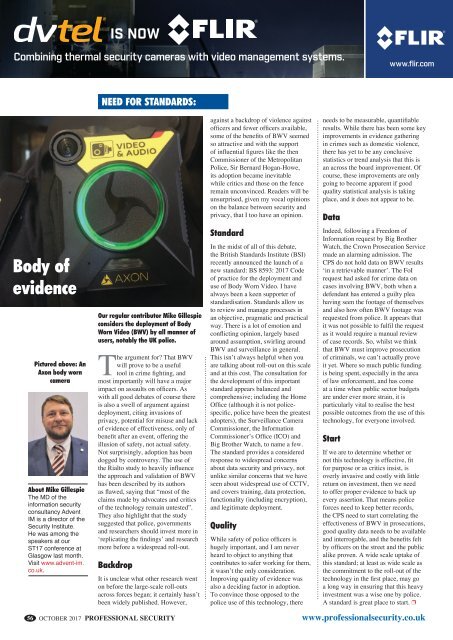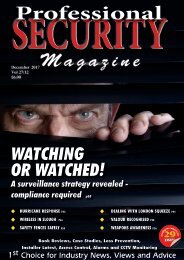27-10draft
You also want an ePaper? Increase the reach of your titles
YUMPU automatically turns print PDFs into web optimized ePapers that Google loves.
IS NOW<br />
Combining thermal security cameras with video management systems.<br />
www.flir.com<br />
Untitled-20 1 18/02/16 10:18<br />
need for standards:<br />
Body of<br />
evidence<br />
56<br />
Pictured above: An<br />
Axon body worn<br />
camera<br />
About Mike Gillespie<br />
The MD of the<br />
information security<br />
consultancy Advent<br />
IM is a director of the<br />
Security Institute.<br />
He was among the<br />
speakers at our<br />
ST17 conference at<br />
Glasgow last month.<br />
Visit www.advent-im.<br />
co.uk.<br />
Our regular contributor Mike Gillespie<br />
considers the deployment of Body<br />
Worn Video (BWV) by all manner of<br />
users, notably the UK police.<br />
The argument for? That BWV<br />
will prove to be a useful<br />
tool in crime fighting, and<br />
most importantly will have a major<br />
impact on assaults on officers. As<br />
with all good debates of course there<br />
is also a swell of argument against<br />
deployment, citing invasions of<br />
privacy, potential for misuse and lack<br />
of evidence of effectiveness, only of<br />
benefit after an event, offering the<br />
illusion of safety, not actual safety.<br />
Not surprisingly, adoption has been<br />
dogged by controversy. The use of<br />
the Rialto study to heavily influence<br />
the approach and validation of BWV<br />
has been described by its authors<br />
as flawed, saying that “most of the<br />
claims made by advocates and critics<br />
of the technology remain untested”.<br />
They also highlight that the study<br />
suggested that police, governments<br />
and researchers should invest more in<br />
‘replicating the findings’ and research<br />
more before a widespread roll-out.<br />
Backdrop<br />
It is unclear what other research went<br />
on before the large-scale roll-outs<br />
across forces began; it certainly hasn’t<br />
been widely published. However,<br />
OCTOBER 2017 PROFESSIONAL SECURITY<br />
against a backdrop of violence against<br />
officers and fewer officers available,<br />
some of the benefits of BWV seemed<br />
so attractive and with the support<br />
of influential figures like the then<br />
Commissioner of the Metropolitan<br />
Police, Sir Bernard Hogan-Howe,<br />
its adoption became inevitable<br />
while critics and those on the fence<br />
remain unconvinced. Readers will be<br />
unsurprised, given my vocal opinions<br />
on the balance between security and<br />
privacy, that I too have an opinion.<br />
Standard<br />
In the midst of all of this debate,<br />
the British Standards Institute (BSI)<br />
recently announced the launch of a<br />
new standard: BS 8593: 2017 Code<br />
of practice for the deployment and<br />
use of Body Worn Video. I have<br />
always been a keen supporter of<br />
standardisation. Standards allow us<br />
to review and manage processes in<br />
an objective, pragmatic and practical<br />
way. There is a lot of emotion and<br />
conflicting opinion, largely based<br />
around assumption, swirling around<br />
BWV and surveillance in general.<br />
This isn’t always helpful when you<br />
are talking about roll-out on this scale<br />
and at this cost. The consultation for<br />
the development of this important<br />
standard appears balanced and<br />
comprehensive; including the Home<br />
Office (although it is not policespecific,<br />
police have been the greatest<br />
adopters), the Surveillance Camera<br />
Commissioner, the Information<br />
Commissioner’s Office (ICO) and<br />
Big Brother Watch, to name a few.<br />
The standard provides a considered<br />
response to widespread concerns<br />
about data security and privacy, not<br />
unlike similar concerns that we have<br />
seen about widespread use of CCTV,<br />
and covers training, data protection,<br />
functionality (including encryption),<br />
and legitimate deployment.<br />
Quality<br />
While safety of police officers is<br />
hugely important, and I am never<br />
heard to object to anything that<br />
contributes to safer working for them,<br />
it wasn’t the only consideration.<br />
Improving quality of evidence was<br />
also a deciding factor in adoption.<br />
To convince those opposed to the<br />
police use of this technology, there<br />
needs to be measurable, quantifiable<br />
results. While there has been some key<br />
improvements in evidence gathering<br />
in crimes such as domestic violence,<br />
there has yet to be any conclusive<br />
statistics or trend analysis that this is<br />
an across the board improvement. Of<br />
course, these improvements are only<br />
going to become apparent if good<br />
quality statistical analysis is taking<br />
place, and it does not appear to be.<br />
Data<br />
Indeed, following a Freedom of<br />
Information request by Big Brother<br />
Watch, the Crown Prosecution Service<br />
made an alarming admission. The<br />
CPS do not hold data on BWV results<br />
‘in a retrievable manner’. The FoI<br />
request had asked for crime data on<br />
cases involving BWV, both when a<br />
defendant has entered a guilty plea<br />
having seen the footage of themselves<br />
and also how often BWV footage was<br />
requested from police. It appears that<br />
it was not possible to fulfil the request<br />
as it would require a manual review<br />
of case records. So, whilst we think<br />
that BWV must improve prosecution<br />
of criminals, we can’t actually prove<br />
it yet. Where so much public funding<br />
is being spent, especially in the area<br />
of law enforcement, and has come<br />
at a time when public sector budgets<br />
are under ever more strain, it is<br />
particularly vital to realise the best<br />
possible outcomes from the use of this<br />
technology, for everyone involved.<br />
Start<br />
If we are to determine whether or<br />
not this technology is effective, fit<br />
for purpose or as critics insist, is<br />
overly invasive and costly with little<br />
return on investment, then we need<br />
to offer proper evidence to back up<br />
every assertion. That means police<br />
forces need to keep better records,<br />
the CPS need to start correlating the<br />
effectiveness of BWV in prosecutions,<br />
good quality data needs to be available<br />
and interrogable, and the benefits felt<br />
by officers on the street and the public<br />
alike proven. A wide scale uptake of<br />
this standard; at least as wide scale as<br />
the commitment to the roll-out of the<br />
technology in the first place, may go<br />
a long way in ensuring that this heavy<br />
investment was a wise one by police.<br />
A standard is great place to start. p<br />
www.professionalsecurity.co.uk<br />
p56 Gillespie <strong>27</strong>-10.indd 1 16/09/2017 19:08










